Minneapolis Institute of Arts
In 1883, business and professional leaders in Minneapolis were organizing art exhibits to bring them into the community. They decided to make a permanent home inside what was then the Minneapolis Public Library.In 1911, Clinton Morrison, the chairman of the First National Bank (US Bank), donated the land where his family's mansion used to sit, and William Dunwoody, partner in General Mills and Chairman of Northwestern National Bank (Wells Fargo) dropped $100,000 as the first donation which pretty much led the way to fill out the $500,000 needed for the new building.
Designed to be an imposing monument, it was only finished to 25% of the original planned space, which allows 4% of the 90,000+ items in the collection to be displayed at any given time.
Affectionately known as MIA (not missing in action), it's home to the largest, most comprehensive Asian art collection in the world.
The Arrival
Getting to MIA is kind of a bear, it's not on any major roads and you have to take several turns and twists off of any major highway. I picked up my editor in Minneapolis next to the George Floyd monument (yes sometimes editing has been interesting in that neighborhood) and drove up Chicago Avenue to Franklin Avenue. The income level disparities in Minneapolis can be seen fairly starkly during this drive.Then I drove west on Franklin Ave to 3rd Ave (lots of avenues in Minneapolis eh?) and into a 1910s neighborhood called Washburn. The mood changes quickly from lower income to bohemian and old money as you head south to the Institute.
Parking is free, and in the winter you get to experience the interesting frigid walk to the entrance.
The Grounds
In the summer, I like parking by the park on the north side and walking across it to the museum for a look at the imposing old entrance. There are also several external pieces of work out here which really makes me think about material selection to survive rain, frost, snow, and other things being outside causes.Entrance
The entrance serves both the institute and the children's theatre. I turn to the right and head to the MIA, and well, in I went.First Floor
The first floor has very limited space that contains light dining, the gift shop, classrooms, and rotating displays. At the time of my visit, it was an African experience setup in Cargill Hall. Things almost feel out of place in the layout on this floor.Second Floor
This floor used to be the main floor a long time ago when this entrance was utilized. (It's still very visible, in a totally old-school protective door and entryway type layout). Given the newer way to enter on the east side, it's now the second stop on the tour, and intensely heavy with Asian items.Growing up in an archaeologist's household, I have a particular mental fight over how items are categorized. I will show you my struggle with Stone Age to Bronze Age Chinese pottery on display at the museum.
Third Floor
The top floor is devoted more to Eurocentric art and coming into the modern eras. The medieval, Renaissance and masters' periods when perspective came back into vogue. This is also an area where many full room interpretations of the 1600s and 1700s are represented which are pretty cool - to me at least. By this point, I was getting actual eyestrain from all the refocusing, and a bit worn down from the actual walking (I did 3 miles just inside the museum that day). This began to affect my mood and my ability to objectively appreciate art that might be on the edge of my tolerance. I really suggest the mezzanine dining area for a break.Summary
A world level museum boasting the largest collection of Chinese art in the world. The Walker family patriarch was an insanely rich lumber baron who collected massively on his trips there. The exhibits feature prime pieces from all times and disciplines with rotating displays housed primarily on the west wing. Two dining locations (the sit down place is much more a break from the museum experience, and they serve wine).You wouldn't find a museum this large or with such a comprehensive collection in a comparably sized city anywhere else in the USA. Also, it's free! Why are you not there already?

